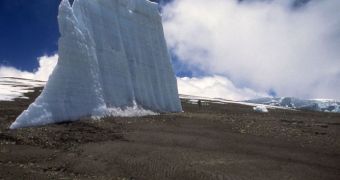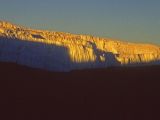Tanzania's Mount Kilimanjaro is one of the most renowned natural landmarks in the world today. Dominating large plains, the mountain looks as if it had its top cut off by a giant wielding a sword. Its iconic image is partially given by the fact that, while in Africa, it has its top covered in snow and ice. While this may be the case at this point, climatologists cannot stop asking themselves for how long it will remain so. The caps on the mountain are highly endangered, experts believe, and immediate action must be taken in order to prevent them from disappearing completely, the US National Science Foundation (NSF) says.
“The loss of Mount Kilimanjaro's ice cover has attracted worldwide attention because of its impact on regional water resources. The remaining ice fields are melting from all sides. Like many glaciers in mid-to-low latitudes, Kilimanjaro's may only be with us for a short time longer,” the Director of the NSF Paleoclimate Program, David Verardo, says. The NSF partially funded the new investigation. Additional money came from the Climate, Water and Carbon Program at the Ohio State University.
According to OSU paleoclimatologist Lonnie Thompson and his team, the new predictions are the last pieces of evidence to be added to the growing mound of proofs that global warming is something governments cannot remain oblivious to for much longer. Details of the team's model appear in this week's issue of the journal Proceedings of the National Academy of Sciences (PNAS). The scientists mention the fact that, oddly enough, changes in cloudiness and precipitation do not play such an important role in determining the extent of the ices atop Mount Kilimanjaro.
“This is the first time researchers have calculated the volume of ice lost from the mountain's ice fields. If you look at the percentage of volume lost since 2000 versus the percentage of area lost as the ice fields shrink, the numbers are very close,” Thompson, who also holds an appointment in the OSU Byrd Polar Research Center, adds. Kilimanjaro “has lost half of its [ice] thickness. In the future, there will be a year when [the] Furtwängler [glacier] is present and, by the next year, it will have disappeared. The whole thing will be gone!” he shares.
“The fact that so many glaciers throughout the tropics and subtropics are showing similar responses suggests an underlying common cause. The increase of Earth's near-surface temperatures, coupled with even greater such increases in the mid- to upper-tropical troposphere, as documented in recent decades, would at least partially explain the observed widespread similarity in glacier behavior,” the expert concludes.

 14 DAY TRIAL //
14 DAY TRIAL // 

